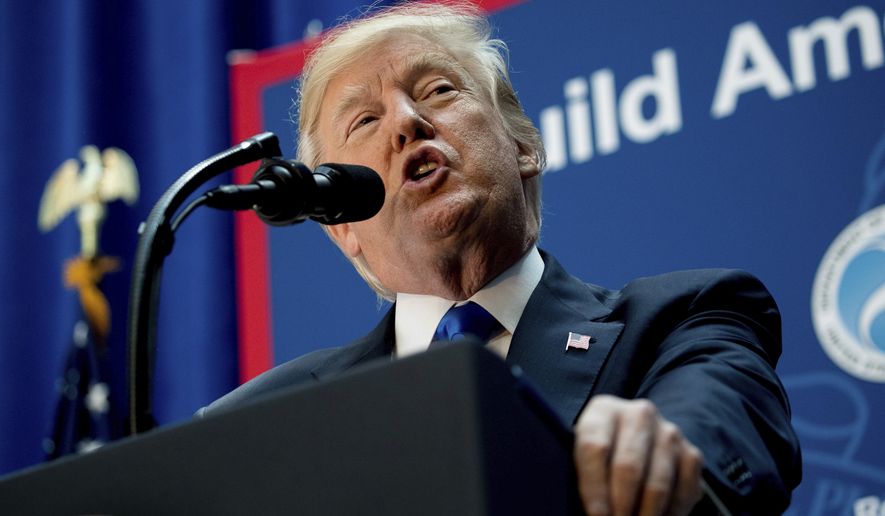President Trump has vowed to pursue a massive program this year to rebuild America’s highways, bridges, railways and airports, but until he can figure out a way to pay the $1 trillion price tag, experts said, the idea is not viable.
With Republican deficit hawks leery of big-ticket projects and Democrats determined to have federal taxpayers foot the whole bill, there’s not much middle ground for the president to find the cash he’ll need.
The White House is still putting finishing touches on a plan that they expect to roll out later this month. It will aim to break the spending logjam by combining regulatory relief, $200 billion in federal dollars and a push for state and local governments to do the rest with alternative financing schemes.
“The president’s infrastructure vision is very clear and is based around two main goals: leveraging federal funds as efficiently as possible in order to generate over $1 trillion in infrastructure investment and expediting the burdensome and lengthy permitting process,” said White House deputy press secretary Lindsay Walters.
The infrastructure plan was a key element of the 2018 agenda that President Trump and Congress’ Republican leaders huddled on over the weekend at Camp David.
But despite widespread agreement that U.S. infrastructure is in severe disrepair, including the American Society of Civil Engineers estimating that $3.6 trillion in repairs are needed immediately, skepticism abounds about the Trump plan.
SEE ALSO: Donald Trump had ‘transformative’ meetings with GOP leaders
“I don’t see how they are going to pay for it. I think that’s one of the reasons they are stalling on it,” said Chris Edwards, tax policy director at the Cato Institute, a libertarian think tank.
Democrats and Republicans are already locked in a budget fight over increasing discretionary or non-defense spending with Democrats pushing for more than the 7 percent increase that Mr. Trump proposed.
On infrastructure projects, Capitol Hill Democrats recoiled from talk of cutting red tape to make infrastructure projects less expensive and shifting much of the financial burden to state and local government.
Senate Democrats put forward their own 10-year, $1 trillion infrastructure plan last year that relies entirely on direct federal spending. They proposed paying for it by closing tax loopholes, but every single Democrat voted against the GOP tax cut bill.
Republicans continue to insist the plan will have bipartisan support, which will be necessary to get a bill through the narrowly divided Senate.
House Transportation and Infrastructure Committee Chairman Bill Shuster has said the package needs to be bipartisan, to be fiscally responsible and include a robust federal component.
Mr. Shuster, Pennsylvania Republican, met with Mr. Trump at the White House last month about the plan. He emerged saying that it will take “many tools in the toolbox” to provide the necessary infrastructure investment — regardless of what the final price tag is — and prepared to consider any funding option.
While the House infrastructure team began putting the plan together a year ago with high expectations that public-private partnerships, also known as P3s, would provide a significant influx of private sector investment in the projects.
They have since backed away from P3s, in which a private enterprise pays for construction of infrastructure in exchange for collecting payment over time from the government or user fees, such as tolls.
Public-private partnerships are still a viable option for some projects, but White House officials said P3s were not “the silver bullet” for the nation’s infrastructure problems.
The administration is researching alternative financing options and urging state and local governments to do the same.
They are shifting the focus of infrastructure spending back to the states and local governments that actually own the majority of government infrastructure, including the interstate highway system.
“As we’ve seen from decades of throwing money at the problem and not moving the needle, direct federal funding isn’t going to solve everything,” said the official. “We will invest at least $200 billion in federal dollars but every single one of those dollars will be leveraged as efficiently as possible to generate additional funding from the state and local governments that actually own, operate, and maintain the vast majority of governmental infrastructure.”
The White House has taken a noncommittal stance on whether the state and local governments generate funds through user fees or P3s.
“Why would we want to stop them from coming up with innovative ways to be fiscally responsible in infrastructure investment?” said the official.
• S.A. Miller can be reached at smiller@washingtontimes.com.




Please read our comment policy before commenting.